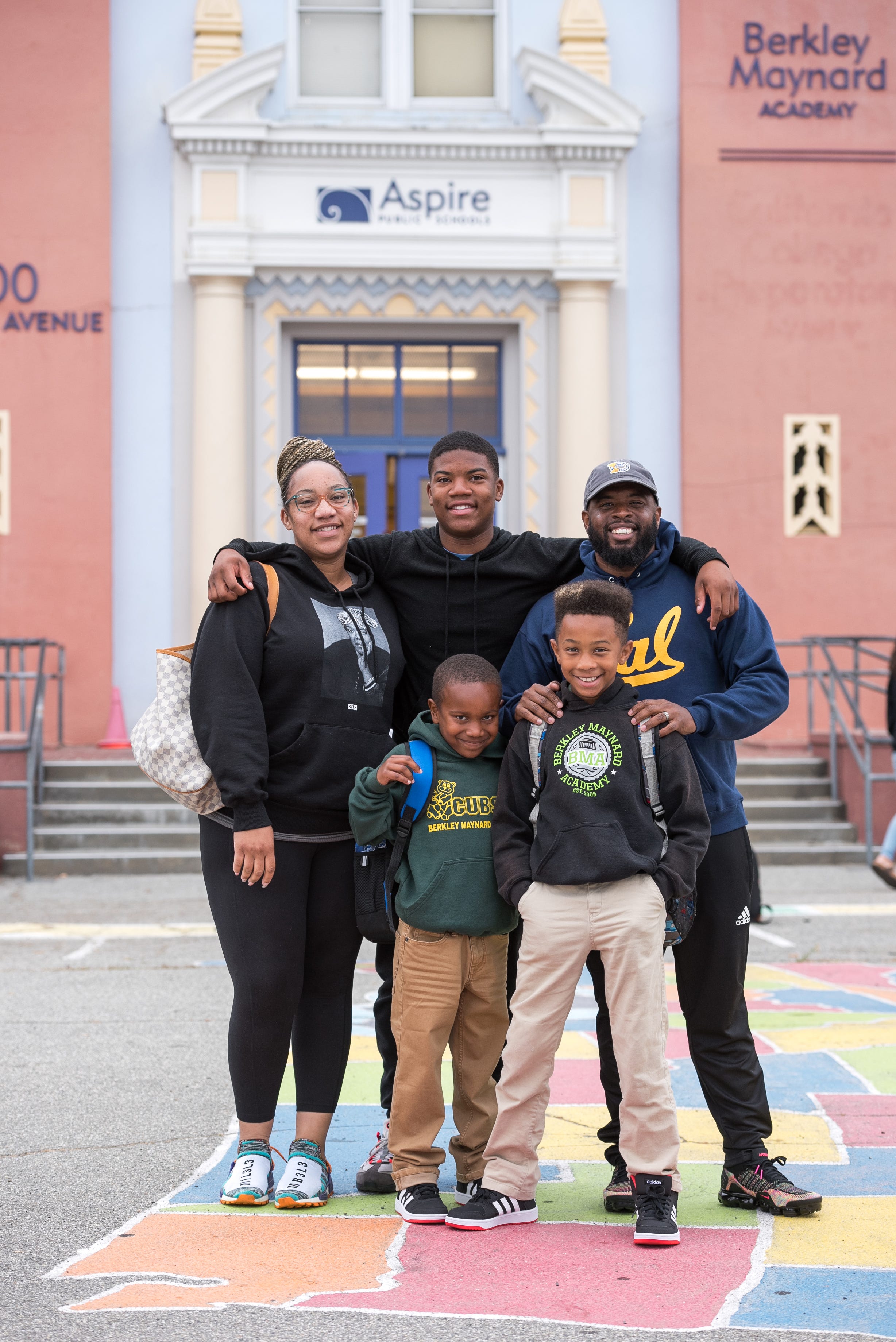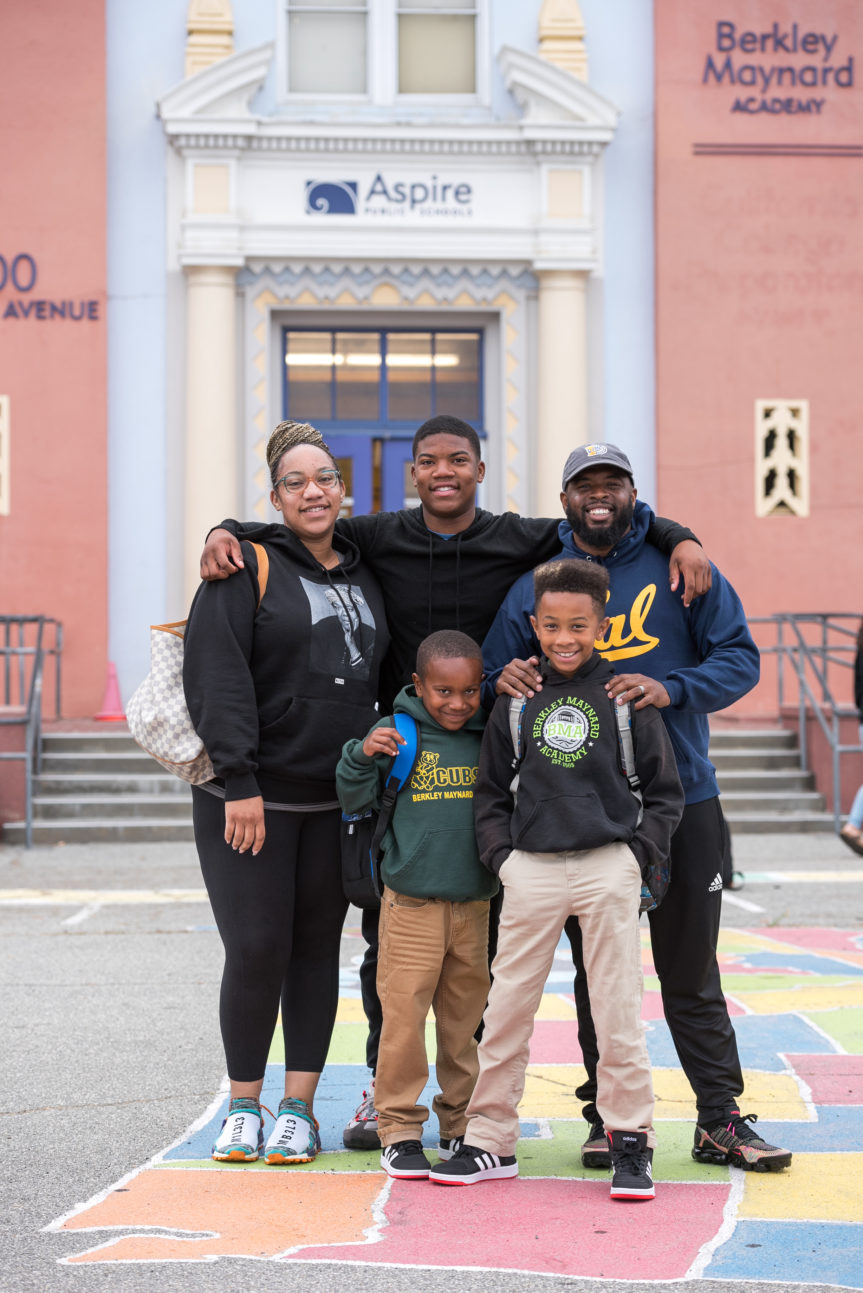A guest post from Families in Action
It took a winding journey to get there, but the Aspire Berkley Maynard Academy (BMA) community ended up in the right place: with a long-term lease from the Oakland Unified School District at the aging facility it has occupied for 15 years, and with the power now to use grant money it already secured to make safety upgrades.
There was some last-minute opposition before the OUSD school board voted 7–0 in April to renew the lease for 40 years, a few who opposed any long-term leases for charter schools in OUSD facilities. But that was overwhelmed by support for the lease, with 200 e-comments sent to the board and families and community members showing up to testify at the school board meeting.
“We really focused on getting clear messages out there about why this is important for our kids, and why this is important for the 98-year-old facility that we’re in where children come to learn each day,” said Aspire BMA principal Jay Stack.

Aspire BMA has been at the Golden Gate Elementary School site for the past 15 years. The building is old — its 100th anniversary is 2022. BMA has intentional connections with that history — its name honors two prominent African Americans (Thomas Berkley, architect, and Bob Maynard, the first Black publisher) and the auditorium is named after Oscar Wright, an Oakland public education icon. Aspire BMA is the only Aspire school that currently rents its facilities from OUSD. For years, it had paid for upgrades to the campus out of its own pocket or funding it could secure: fixing the roof and electrical system, partnering with for a new playground.
Aspire BMA leadership had applied for, and was granted, a $20 million loan to upgrade the facility through the state Prop 51 program, passed by voters in 2016 and includes $3 billion in funding for building upgrades. The grant, though, is set up in a sort of 1:1 or matching deal. “If you can afford $10 million in loan repayments, then you can have a $10 million grant,” Aspire BMA principal Jay Stack said. “If you can only afford $1 million in loan repayments, then you can only have $1 million in loan repayments.”
After that grant was secured in 2017, there was a lot of celebration and some misunderstanding of how the grant worked and what it could cover. “We’re bringing in architects, people wanted to build a swimming pool and put grass everywhere,” Stack remembers. “I had to be like, ‘Actually all we can do is upgrade our fire and electrical systems’ because repairing schools is an expensive industry. One fire detector in a classroom costs like $2,000.’”
The BMA leadership felt something in the $5–7 million range was feasible and OUSD approved the grant application, which was then approved at the state level. Then came a two-year standstill as OUSD underwent a leadership change and had to manage a budget shortfall. “There were some massive shortfalls in the school system and everything was put on pause,” Stack said.

In early 2020, things started happening. “As there was more facilities master planning happening, and work to procure money to rehabilitate and renovate a lot of our schools, I think that’s where we had a window to come back to the board and say, ‘We got this grant two years ago,’” Stack said. ‘Can we use it?’”
Then came the opposition from a few community members at the school board’s first reading to approve the lease, which was more than countered by the Aspire BMA community’s support. Stack wasn’t surprised how the community rallied.
“We have a lot of strong family support,” he said. “I’ve been here at this school for 14 years, next year will be 15, and we just have a really strong community here who have a really strong connection to this area of Oakland.”
Stack mentioned that some of the Aspire BMA families that have long and historical connections to this part of North Oakland were priced out of living in the area. A majority of the students (55%) are African American and 42% are Latino/a students; 79% receive free reduced lunch, 30% are English Language Learners and 12% are students with disabilities.
Some commenters during the board meeting said Aspire BMA didn’t want to renegotiate their lease to better serve students with disabilities, a charge Stack strongly disagrees with.
“We serve all students with disabilities, we’re an inclusion school,” Stack said. “We use a lottery, we don’t skim from the top. We take anyone who applies and gets in through the lottery system. When I started as principal we were at 6 percent (students with disabilities) and I think there’s a lot more information going around to families that we serve students with disabilities well.”

There are a few more hurdles before all the safety upgrades can be completed. There is of course COVID-19 shutting down construction for the time being. The hope was the construction could be completed during the summer when no students were on campus, but that’s up in the air now. Stack also said the school must renegotiate with the state about using some of the grant money to replace some portables on campus that are used for a music room, among other uses to ensure they’re ADA compliant.
“It’s just not happening this summer given the climate for construction,” Stack said.
Whatever happens, the resilient Aspire BMA community has been through it before, and it means a lot to provide students with a safe building.
“We really rallied families and the greater community around the importance of having this building and having it upgraded for our students to learn in,” Stack said.Families in Action for Quality Education
WRITTEN BY
Families in Action
Following

Families in Action for Quality Education
Following

